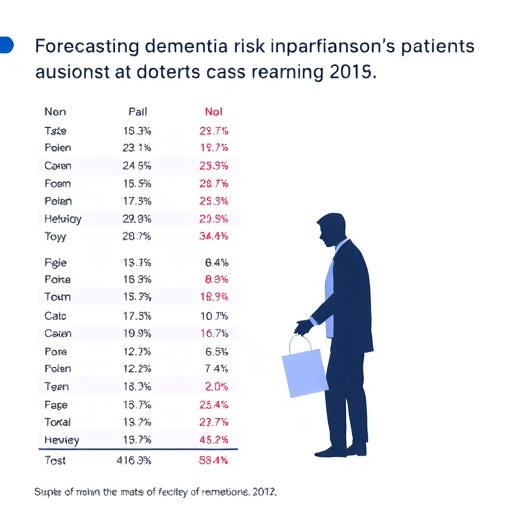In a groundbreaking advancement for neurodegenerative disease research, a recent study published in the prestigious journal npj Parkinson’s Disease provides compelling new insights into the prediction of dementia among individuals suffering from Parkinson’s disease (PD). Spearheaded by a team including Aborageh, Hähnel, and Martins Conde, this pioneering research has the potential to revolutionize clinical approaches by enabling earlier and more accurate identification of those patients at elevated risk of developing dementia, a debilitating complication that affects a substantial subset of Parkinson’s patients.
Parkinson’s disease is primarily characterized by motor symptoms such as tremors, rigidity, bradykinesia, and postural instability, attributable to the progressive loss of dopaminergic neurons in the substantia nigra of the brain. However, cognitive decline culminating in Parkinson’s disease dementia (PDD) poses an equally significant threat to the quality of life and functional independence of patients. Despite the high incidence of dementia in PD, prediction methods have historically been inadequate, leaving clinicians without reliable tools for early intervention.
The research team employed a multifaceted approach, integrating neuroimaging data, clinical evaluations, and advanced statistical modeling to identify predictive biomarkers correlated with cognitive deterioration. The researchers utilized volumetric MRI scans alongside functional connectivity analyses to detect subtle structural and network changes in the brain preceding cognitive symptoms. Such technical rigor allowed for a comprehensive characterization of the neural substrates implicated in the transition from Parkinson’s to Parkinson’s dementia.
Critically, the study leveraged machine learning algorithms, incorporating a range of demographic, clinical, and neuroimaging variables into predictive models. These computational methods, adept at deciphering complex multidimensional data, markedly improved the specificity and sensitivity of dementia risk estimation in PD populations. By employing cross-validation techniques, the team ensured that their predictive model was not only accurate but also generalizable across diverse patient cohorts.
One of the notable revelations of this study was the identification of early atrophy in the hippocampus and entorhinal cortex as potent imaging biomarkers for imminent dementia in Parkinson’s patients. These regions, heavily implicated in memory consolidation and spatial navigation, exhibited volume reductions even before overt cognitive symptoms manifested. By tracking subtle changes through high-resolution imaging, clinicians could foresee cognitive impairment years in advance, allowing for timely therapeutic interventions.
Moreover, the research highlighted alterations in the default mode network (DMN), a critical functional brain network active during rest and involved in internal thought processes. Disruptions in DMN connectivity were observed to correlate strongly with declining cognitive status. This finding aligns with previous literature implicating DMN dysfunction in various neurodegenerative disorders, underscoring the network’s role as a neurocognitive biomarker.
Adding a novel dimension, the study also accounted for non-motor symptoms such as sleep disturbances and mood disorders, which are increasingly recognized as harbingers of neurodegeneration. These clinical features significantly improved the predictive power of the model, suggesting that a holistic assessment encompassing both motor and non-motor domains is vital for dementia risk stratification in PD.
The longitudinal nature of the research, tracking participants over multiple time points, afforded an unprecedented view of disease evolution. This enabled the differentiation between transient cognitive fluctuations and persistent decline, a distinction crucial for accurate prognosis. The ability to monitor progression over time enhances personalized medicine approaches, facilitating dynamic risk assessment and timely modifications to care plans.
From a therapeutic standpoint, early identification of high-risk individuals paves the way for preventive strategies and clinical trials targeting cognitive decline. Neuroprotective agents, cognitive rehabilitation, and lifestyle modifications could be deployed more effectively when clinicians are equipped with predictive insights, potentially altering disease trajectories and improving patient outcomes.
The study’s methodological sophistication, including rigorous statistical controls and validation cohorts, addresses prior criticisms of predictive modeling studies, such as overfitting and limited reproducibility. By setting a new standard for predictive accuracy in Parkinson’s dementia, this work serves as a cornerstone for future research aiming to elucidate the mechanisms linking PD to dementia.
Furthermore, the implications of this research extend beyond Parkinson’s disease, offering a framework adaptable to other neurodegenerative conditions where dementia risk prediction remains elusive. The integration of multimodal data and machine learning represents a paradigm shift in neurology, emphasizing precision diagnostics and individualized patient care.
The research team also discusses the ethical considerations in deploying predictive models in clinical practice. While prognostication can empower patients and clinicians, it demands sensitivity to the psychological impact of risk disclosure and the need for supportive counseling protocols. Balancing scientific innovation with compassionate care remains a cornerstone of translational neuroscience.
In summary, this extensive study lays a robust foundation for enhancing dementia prediction in Parkinson’s disease, combining technical ingenuity with clinical relevance. As the aging population continues to grow globally, the burden of neurodegenerative disorders will intensify, making such advances critically timely and impactful.
Emerging from this research is a hopeful narrative that, through the power of advanced neuroimaging, computational analytics, and integrated clinical assessment, the longstanding challenge of anticipating Parkinson’s dementia is finally being addressed. This could mark the beginning of a new era in which cognitive outcomes for Parkinson’s patients become more manageable and less catastrophic.
The study’s findings invite further exploration into targeted therapies and preventive measures tailored to those genetic and phenotypic profiles most vulnerable to cognitive decline. It also highlights the necessity for expanded datasets and collaborative international studies to refine and validate predictive models across heterogeneous populations.
This significant contribution not only enriches scientific understanding but holds tangible promise for transforming patient care paradigms. By embracing complexity with cutting-edge technology and multidisciplinary expertise, the pathway to mitigating dementia in Parkinson’s disease is becoming clearer, more precise, and within reach.
As ongoing research builds upon this work, a future where cognitive decline in Parkinson’s can be reliably anticipated—and ultimately prevented—draws nearer, offering hope and improved quality of life to millions worldwide.
Subject of Research: Predicting dementia in people with Parkinson’s disease through imaging, clinical, and computational methods.
Article Title: Predicting dementia in people with Parkinson’s disease.
Article References:
Aborageh, M., Hähnel, T., Martins Conde, P. et al. Predicting dementia in people with Parkinson’s disease. npj Parkinsons Dis. 11, 126 (2025). https://doi.org/10.1038/s41531-025-00983-4
Image Credits: AI Generated




